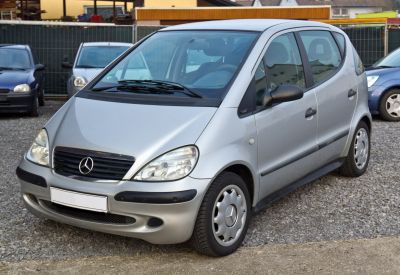 1997 Mercedes-Benz A-class (W168) Dimensions, Size & Specs
1997 Mercedes-Benz A-class (W168) Dimensions, Size & SpecsMeasurements of the 1997 Mercedes-Benz A-class, engineered for optimal performance and comfort
| Dimensions | |
|---|---|
| Length: | 3575 mm140.7 in11.7 ft |
| Width: | 1719 mm67.7 in5.6 ft |
| Height: | 1590 mm62.6 in5.2 ft |
| Trunk Capacity: | 350-390 liter12.4-13.8 cu ft |
| Trunk Capacity (Max): | 1700 liter60.0 cu ft |
| Weight Specifications | |
| Curb Weight: | 1020-1185 kg2249-2612 lbs |
| Maximal permitted Weight: | 1480-1560 kg3263-3439 lbs |
| Tire Specifications | |
| Rims Sizes: | 15-inch rims:
|
| Tire Sizes: |
|
The Mercedes-Benz A-class (W168) is a compact hatchback introduced in 1997 and produced until 2001, marking Mercedes' entry into the small car segment with a fresh and innovative design. Measuring 3575 mm (140.7 inches) in length, 1719 mm (67.7 inches) in width, and 1590 mm (62.6 inches) in height, the W168 offers a surprisingly spacious cabin and practical dimensions suitable for urban driving. Despite its compact footprint, this model is engineered for efficiency and comfort, with a curb weight ranging between 1020 and 1185 kilograms (2249 to 2612 pounds), making it relatively lightweight for a premium brand hatchback. The maximum permissible weight varies from 1480 to 1560 kilograms (3262 to 3440 pounds), allowing for a decent payload capacity. When it comes to cargo space, the A-class stands out with a luggage capacity of 350 to 390 liters (12.3 to 13.8 cubic feet) with the rear seats in use. Folding the rear seats significantly expands the available space to an impressive 1700 liters (60 cubic feet), making it highly versatile for carrying larger items. The car comes equipped with rims sized 5.5J x 15 and 5.5J x 15, paired with tire size options including 175/65 R15, 195/50 R15, and 155/70 R15, offering a balanced approach to ride comfort and handling. Overall, the Mercedes-Benz A-class (W168) exemplifies a well-designed compact hatchback that blends luxury, efficiency, and practicality, making it a landmark model for Mercedes-Benz's presence in the small car market during the late 1990s and early 2000s.
Discover the standout features that make the 1997 Mercedes-Benz A-class a leader in its class
Have a question? Please check our knowledgebase first.
The Mercedes-Benz A-class (W168) hatchback produced between 1997 and 2001 measures 3575 mm (140.7 inches) in length, 1719 mm (67.7 inches) in width, and 1590 mm (62.6 inches) in height. These compact exterior dimensions position it firmly within the subcompact hatchback category, allowing it to navigate urban environments with ease while providing practical interior space.
The curb weight of the Mercedes-Benz A-class (W168) ranges between 1020 kg and 1185 kg (2249 lbs to 2613 lbs), depending on trim and equipment. Its maximum allowable weight, including passengers and cargo, ranges between 1480 kg and 1560 kg (3262 lbs to 3441 lbs). These weight figures reflect the compact size and engineering focus on efficiency while maintaining safety and stability.
The standard luggage capacity of the Mercedes-Benz A-class (W168) hatchback is between 350 and 390 liters (12.4 to 13.8 cubic feet), which offers reasonable trunk space for its class. When the rear seats are folded down, the cargo volume expands significantly to approximately 1700 liters (60 cubic feet), allowing for transport of larger items or increased load flexibility.
Yes, the Mercedes-Benz A-class (W168) fits comfortably into a standard garage. With dimensions of 3575 mm (140.7 inches) in length, 1719 mm (67.7 inches) in width, and 1590 mm (62.6 inches) in height, it is compact enough to park easily in most residential garages, which typically measure around 2400 mm (94.5 inches) in width and 4800 mm (189 inches) in length. Its height also ensures no issues with garage door clearance.
The Mercedes-Benz A-class (W168) from 1997 was actually the first generation of this model line, meaning it has no direct predecessor within the A-class range. However, compared to previous compact Mercedes-Benz models such as the 190 series or early C-class hatchbacks, the W168 is notably smaller, emphasizing city-friendly dimensions and a unique sandwich floor design that improved interior space utilization despite its compact external footprint.
The Mercedes-Benz A-class (W168) was notably compact compared to many competitors in the subcompact hatchback segment during its era. For instance, it was shorter and narrower than cars like the Volkswagen Golf Mk4 and Ford Focus from the late 1990s. Its innovative design maximized interior space in a smaller exterior footprint, making it stand out in a class typically dominated by slightly larger vehicles.
The original equipment rim sizes for the Mercedes-Benz A-class (W168) are 5.5J x 15 and 5.5J x 15, typically paired with tire sizes such as 175/65 R15, 195/50 R15, and 155/70 R15. These rim and tire combinations balance ride comfort, handling, and road grip, optimized for the vehicle's lightweight and compact design.
Despite its compact exterior dimensions (3575 mm length, 1719 mm width, and 1590 mm height), the Mercedes-Benz A-class (W168) offers a surprisingly spacious and comfortable interior. This is largely due to its pioneering sandwich floor construction, which raises the floor and places key components underneath, allowing for better legroom and safety. The cabin design maximizes usable space for both front and rear passengers, ensuring comfort within a small footprint.
The Mercedes-Benz A-class (W168) features a relatively modest ground clearance, suited for urban and suburban driving conditions, though exact figures vary slightly by suspension setup. Importantly, it utilizes a front-engine, front-wheel-drive layout, which is typical for its class and enhances interior space by eliminating the need for a driveshaft tunnel, further contributing to cabin roominess and driving dynamics.
The compact size of the W168, combined with a modest curb weight between 1020 and 1185 kg (2249 to 2613 lbs), ensures excellent maneuverability in tight urban spaces. Its relatively short length (3575 mm or 140.7 inches) and narrow width (1719 mm or 67.7 inches) make parking in crowded city areas simpler. Additionally, the car’s lightweight construction contributes to responsive handling and efficient fuel consumption during stop-and-go city traffic.
Discover similar sized cars.

| Production: | 2001-2004 |
|---|---|
| Model Year: | 2001 |
| Length: | 3606-3640 mm142.0-143.3 in |
| Width: | 1950 mm76.8 in |
| Height: | 1575-1587 mm62.0-62.5 in |

| Production: | 2014-2019 |
|---|---|
| Model Year: | 2014 |
| Length: | 3395-3525 mm133.7-138.8 in |
| Width: | 1666 mm65.6 in |
| Height: | 1543-1554 mm60.7-61.2 in |
